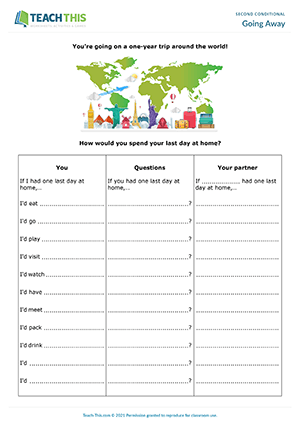Conditional Clauses Speaking Activities For Preschoolers

Tips and ideas from Kerry Maxwell and Lindsay Clandfield on teaching reported speech. Introduction Reported speech is a very rich grammar area to teach because: • It can involve considerable manipulation of form. • It’s a very easy piece of grammar to locate and exploit with texts. The activities here are divided into different kinds of drill, ways of exploiting texts and analysis. Activity: Basic substitution At it’s most basic, you can simply read out a sentence and ask the students to rephrase it beginning with He said /She said For example: • T: I don’t like it.
• Ss: He said he didn’t like it. • T: I hate it. • Ss: He said he hated it. This can be made a little more interesting in the following ways: Activity: Chain reports Version 1 The following activity is a variation of the well-known 'broken telephone'. Whisper a sentence in English to a student. That student then whispers it to another and so on until the last student has to say aloud what was said originally.
If you loved the momemt your little spoke her first words, wait till she starting speaking in sentences. Read to find out when you expect this toddler milestone.
Version 2 If the above seems too easy, ask students to alternate reported speech/direct speech. If they hear it in reported speech they put it back to direct speech and vice versa.
For example: • T: I like it. • S1: He said he liked it. • S2: I like it. • S3 Activity: I didn't get that. What did she say? This is a quick question drill.
Ask a student a question. After they answer, ask another student what was said. For example: • T: Tomas, how did you get to class today?
• S1: I came by car. • T: Sorry, I didn’t get that.
Yvonne, what did Tomas say? Windows 7 drivers download. • S2: He said he had come by car. Activity: Mingle Prepare a series of cards/slips of paper, each with a different sentence. Here are some examples. We met at last year’s party.
Create enough cards so that each student has one. You can repeat the same sentences on other cards. Explain that you want the students to role-play the following situation. They are all at a very formal cocktail party. Everybody must circulate and talk to each other.
The trick is they must say what is on their card and as little else as possible. If you have a CD player or cassette player in the classroom, you could play some quiet music in the background during the mingle. After five minutes (or however long it takes for most students to have spoken to each other) tell everyone to sit down again. Ask people to report back on what other people told them, using reported speech. Activity: Text clarifications This is another teacher-led activity that also focuses on listening skills.
It uses an oral text generated by the teacher. For this activity you need to prepare the following: • a short anecdote (2 minutes long) related to the topic that you are already doing in class (e.g. If you are doing holidays, make it about holidays); • four or five sentences that contradict things in your anecdote. Write the sentences on the board. Read them out to the students. Now explain that you are going to tell a story, but that some of the facts in the story are different.
The students must listen carefully. When they hear a fact that is different from those on the board, someone must interrupt you and seek clarification, using the following structure. Excuse me, but didn’t you say that? (include what you had said earlier, the facts that are on the board). Here is an example: T writes on the board: • I live in a big house.
• I’m married. • I don’t have any children. The teacher reads out the sentences and then she gives the instructions for the activity. She begins the story: • T: Well, the other day I was in my flat. It’s a small flat in the city centre • S: Excuse me, didn’t you say you lived in a big house?
• T: Ah yes, I did say that. So, it was in my big house. My boyfriend was at work • S: Excuse me, didn’t you say you were married? • T: Of course.
I’m married, I meant to say my husband was at work and the baby was crying • S: Excuse me, didn’t you say you didn’t have any children? • T: That’s right. It isn’t my baby, it’s my sister’s baby.
Activity: Reported interviews For this activity, search around the internet for an interview. This kind of activity works best if the interviewee is someone that your class is interested in, or at least someone they have heard about. • Select some of the interview from the webpage and paste into a word document. Make copies for every two students in the class. In class, divide the students into pairs. • Distribute the interview and ask them to work together and make a reported version it.
• Give them a word limit (150 words). When they have finished their draft report, have them swap reports with another pair. Ask them to reduce the report now to 100 words. Circulate and help.
Activity: Reporting back – famous interviews In this activity, students create the interview themselves. Divide students into groups. Tell the groups that they must do the following: • Decide on a famous person (living or dead) who they would like to interview.
- суббота 20 октября
- 4